“With grateful thanks to Margaret Purdom for permission to reproduce extracts from her history of the parish.”
Introduction
The parish of St. Patrick, Langley Moor was founded in 1876. The parent mission was St. Herbert of Croxdale and was attached to Croxdale Hall, the ancestral home of the Salvin’s. The first Rector of St. Patrick’s was the Rev. James Hanley who came in 1876 to minister to a flock of at least 1,000 people most of them being Irish immigrants who had found work in the local coal mines.
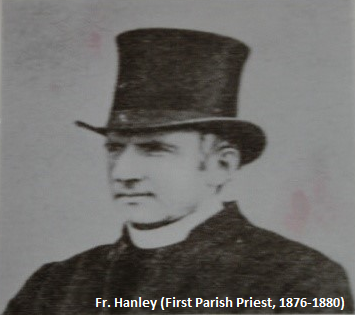
There was no church, school or presbytery so Fr. Hanley rented a house in High Street, Langley Moor and said Mass in a room in a Catholic house in the same street. Afterwards he moved to a more commodious house and said Mass in a large room in the Littleburn Hotel, then under Catholic management. In 1879 he erected a large zinc building which served as a church and school for over twenty years.
In 1880 Fr. Hanley was recalled to Ireland. Fr. Richard Hannon came as the second Rector in 1880. He built St. Patrick’s Presbytery in 1885 and also bought additional land in 1884. He died in hospital after an operation in 1889.
Fr. Joseph Thorman was the third Rector, appointed in 1899. He built the school to accommodate 307 children and the old zinc building was then used solely as a church until October 8th 1911. Fr. Thorman was transferred to St. Andrew’s, Newcastle upon Tyne in December 1906. The Rev John Parker came as fourth Rector on December 29th 1906 from Wigton, Cumberland.
Plans for the New Church
Fr. Parker continued the aim of Fr. Thorman which had been to have a new church built as soon as it was financially possible. He had plans drawn up to a Gothic design by Mr Edward Kay of Stockton on Tees with seating for four hundred and fifty persons. The estimated cost of the new church was £3,000 and by 1909 Fr. Parker had £500 towards it and could submit the plans. He was advised by the Bishop to wait until he had £1,000.
Early in 1910 the plans were passed by the Urban District Council and the parish was allowed to borrow £1,200 towards the cost. Arrangements could then be made for the building of the church which was undertaken by Messrs. George Gradon and Sons of Durham.
The great day when the foundation stone would be laid arrived on Saturday October 1st 1910. During the course of the next year the parishioners were able to watch the gradual building of a most beautiful church. It was faced with stone and consisted of nave and aisles with sanctuary and two side chapels. Two sacristies were attached and the interior showed an arcade of five arches to each side of the nave resting on octagonal columns with foliated capitals. The roof was one of open hammer beam construction and the church was eighty feet in length by forty five feet in width.
The Official Opening of the Church
St. Patrick’s Church was officially opened on Sunday October 8th 1911. The chief service on the Sunday was the Solemn High Mass* which was sung at 11 a.m. by Monsignor Brown, President of Ushaw College. He was assisted in the service by Dr. Burgess (Deacon), Fr. Thorman (Sub-Deacon), and Dr. Towers (Master of Ceremonies). Mr. J B Slack, organist of St. Godric’s Church played the voluntaries and conducted the choir, and Miss Salkeld played the organ. In the evening there was a large congregation present for Benediction of the Blessed Sacrament.
On Tuesday October 10th Bishop Collins and a large number of distinguished members of the church entered the new church for a service at 11 a.m.Thirty six priests were in attendance and joined a large congregation in the church. Solemn Episcopal Mass was sung by the Bishop with music provided by the choir from Ushaw College conducted by Fr. Bonney, while Mr. Henshaw presided at the organ.
The church was described as ‘an ornament to the neighbourhood’ in 1911 and it still continues to live up to this description. The church itself is an imposing building which today is enhanced by being surrounded by the most beautiful and lovingly cared for garden, making the approach to the church most attractive whether summer or winter.
Fr. Parker’s Era (1906-1934)
Within three years of the building of the church a World War was declared in August 1914 and young men rushed to enlist to fight in this war having no idea of the horrors they were going to have to endure. Many men from the parish went to the war and forty of them were killed leaving heartbroken families behind them.
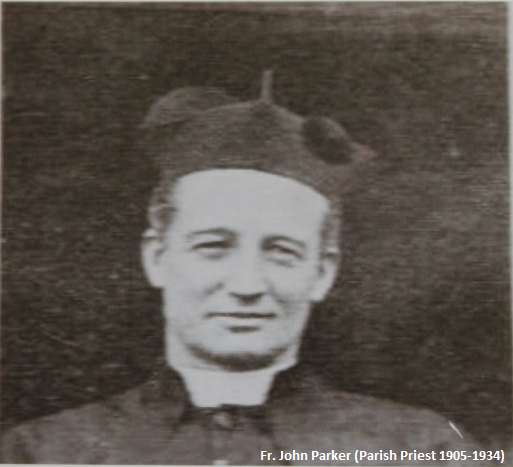
During these difficult years, Fr. Parker did his utmost to comfort and sustain his people and there can be no doubt of their appreciation of him, which they demonstrated so clearly, on the occasion of his Silver Jubilee of ordination to the priesthood in 1919.
He had been born in Preston, Lancashire and was educated at Ushaw College where he was ordained on the 29th April 1894. After ordination he served at St. Michael’s, Newcastle before starting a new mission at Benwell. He was then transferred to Wigton in Cumberland, from where he came to St Patrick’s in December 1906.
He organised the building of the church at a final cost of £4,000. It was his ambition to pay off this debt and live to see the consecration of his church. While Fr. Parker was ministering to his people as a worshipping community he was also keeping them together socially. After the building of the new church, the zinc building which had served as a church and school for over twenty five years now became the hub of social activities.
Fr. Parker formed a men’s club, which among other things, promoted events like whist drives and dances. The Catholic Women’s League, which had been founded in England in 1906 and in our diocese in 1911, formed a branch at St. Patrick’s, which was to flourish until the 1980s. The Legion of Mary and Catholic Young Men’s Society were also established.
By 1932 Fr. Parker had been in the parish for 25 years. The parishioners felt that this occasion must be marked to show the affection in which he was held. A tea and social was held in his honour at which he was presented with an easy chair, a set of breviaries and an umbrella on behalf of the different organisations in the parish.
The following year, 1933, Fr. Parker’s great ambition was attained when he was able to pay off the remaining debt on the church and thus make it possible to have St. Patrick’s church consecrated. Considering some of the hard times endured during the 22 years since the building of the church this was a remarkable achievement on behalf of priests and people.
The Consecration of the Church
On Tuesday October 10th 1933 the church was consecrated by Dr. Thorman, former parish priest and now Bishop of Hexham and Newcastle.The Consecration took place in the presence of a large assembly of priests and members of the congregation. The Bishop stood outside and sprinkled the walls of the church three times with holy water. Then he struck the door with the ash end of this crozier and cried out…
“Lift up your gates, O ye princes,
and be lifted up O eternal gates,
and the King of Glory shall enter in”
“Who is this King of Glory”
said the Guardian Deacon inside the church.
“The Lord strong and mighty,
the Lord mighty in battle”
answered the Bishop
At the third demand the door was opened by the Guardian Deacon, and the Bishop, making the sign of the cross with his pastoral staff on the threshold, entered and took possession in God’s name.
The enshrining of the relics of martyrs, the anointing with chrism of the altar and church walls, the blessing of the altar cloths and clothing of the altar followed. The Mass was then said by the Bishop.
Each member of the congregation was presented with a booklet explaining the Consecration of a church and giving a short history of the parish.
Fr. Parker achieved his ambition to see his church consecrated but lived for only six months afterwards. The parish lost their popular priest of the last 27 years when he died in April 1934 aged 65.
Fr. Thomas Vincent Meagher (1934-1936)
Fr. Parker’s successor as parish priest was Fr. Thomas Meagher who came to St. Patrick’s in May 1934. Ordained at Ushaw College in 1909, he became Professor of Languages there and taught French from 1911 – 1921. The fact that he was on sick leave from 1930 to 1932 could indicate that he did not enjoy good health. He returned to his family home at Preston where he died on March 4th 1936, aged fifty.
Fr. John McCormack (1936-1938)
Fr. John McCormack was the next parish priest appointed to St. Patrick’s Parish. He came in April 1936 and did not have a curate to help him. He had been trained for the priesthood at the Beda College in Rome and, after ordination, taught at Ushaw College until 1934. In 1938 Fr. McCormack organised a huge refurbishment of St. Patrick’s Club Hall and had a new maplewood dance floor installed. His time at St. Patrick’s came to an end in May 1938 when he was moved to St. Mary’s, Stockton on Tees where he remained until his death on October 25th 1953.
Fr. Austin McShane (1938-1976)
Fr. McShane came as parish priest to St. Patrick’s in May 1938 having previously served in Easington, Esh Winning and Stanley. He had been educated at Ushaw College where his studies were interrupted by the First World War, in which he served for two years as a lieutenant in the Machine Gun Corps. He was ordained at Ushaw on April 21st, 1924.
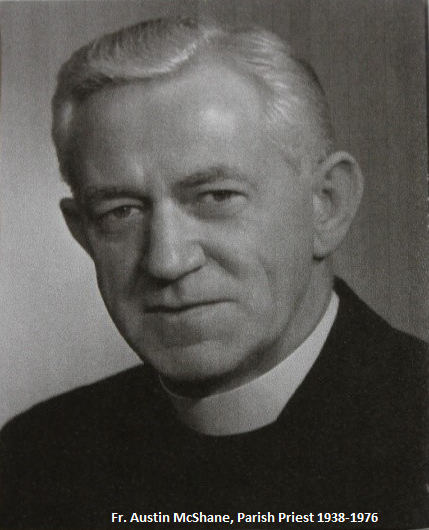
One year after Fr. McShane’s arrival World War 2 was declared, which brought disruption and change to the parish.Shortly after the war was declared, the Military Camp, then in existence at Brancepeth, was occupied by many of the Northern Regiments and Fr. McShane was appointed as Catholic Chaplain to the forces billeted there.
Fr. McShane celebrated Mass every Sunday in the camp cinema. Fr. Peter Stanley was appointed as curate in 1939 and stayed until 1941 when he was succeeded by Fr. Herbert Armstrong who remained as curate until 1947. Some older parishioners can recall happy times spent during the war taking part in parish productions which were organised by Fr. Armstrong and Miss Hughes (teacher in the school).
Post-War Changes
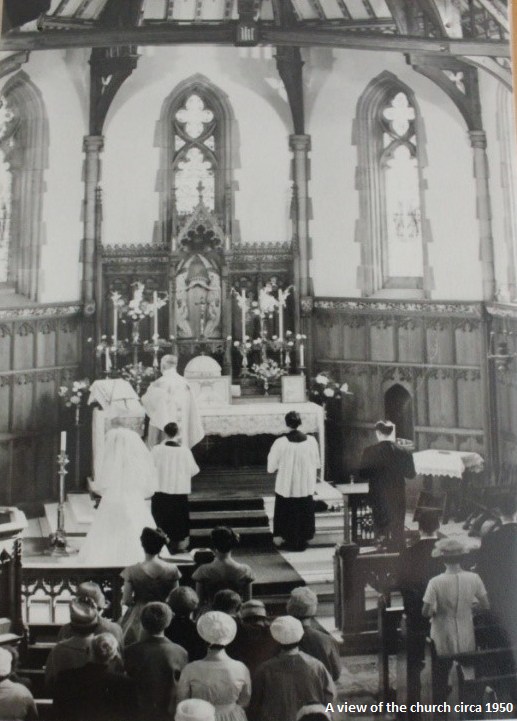
On April 21st 1949 Fr. McShane celebrated the Silver Jubilee of his ordination to the priesthood. To mark the occasion he organised a major refurbishment of the church which included a new roof and all the windows being replaced with stained glass. To design and install the stained glass windows Fr. McShane chose a Birmingham firm named Hardman, the quality of whose windows was recognised as superb. Their windows are found in the Houses of Parliament and as far afield as St. Andrew’s Cathedral in Sydney, Australia and St. Mary’s Cathedral in the same city, as well as our own church of St. Patrick’s at Langley Moor. Fr. McShane’s celebration of his Silver Jubilee gave the parish an even more beautiful church with the enhancement of these wonderful windows which continue to inspire the congregation.

In 1958 Pope Pius 12th died after a reign of 19 years. His successor, Pope John 23rd decided to call a Second Vatican Council the first session of which took place from October 11th 1962 to December 8th 1962. Pope John 23rd died in June 1963 and was succeeded by Pope Paul 6th who proceeded with the 2nd Vatican Council until its final session in December 1965. There was a gradual introduction of the dialogue Mass, the use of English and sermons at Mass. The new rite of Low Mass and use of English in the administration of the Sacraments came into force on November 28th 1964. By this time Fr. McShane had been a priest for forty years so it must have been quite a challenge for him to lead his parishioners through all these alterations.

Fr. McShane celebrated his Golden Jubilee in 1974 having spent the previous 36 years as parish priest of St. Patrick’s. Fr. McShane became ill in 1976 and was looked after in the parish presbytery by his housekeeper until his death on October 7th. He was buried in Meadowfield Cemetery close to the church to which he had given half the years of his life.
Fr. Thomas Laidler (1976-1979)
Fr. Thomas Laidler succeeded Fr. McShane as parish priest in 1976. Fr. Laidler was ordained at Ushaw on June 29th 1941 and served in Hebburn and Whitley Bay before becoming the first parish priest of the Immaculate Heart of Mary, West Monkseaton, which had formed in 1969. One of his innovations was a weekly newsletter which commenced in late 1976 and continued through his three year term.

His first move towards re-ordering the church was to have the altar rails, baptismal font and pulpit taken from the church. In May 1979 Fr. Laidler moved to Prudhoe where he remained as parish priest until his retirement to Carntyne Residential Home, Hexham in June 1991. He died in Hexham on July 9th 1994. Fr. Laidler had started the re-ordering of the church but it was left to his successor to carry it through to completion.
Fr. Joseph Hughes (1979-2001)
Fr. Hughes succeeded Fr. Laidler as parish priest of St. Patrick’s in May 1979. The message Fr. Hughes gave to the congregation was “let the renewal of ourselves go hand in hand with the renewal of our church”. Fr. Hughes had Eucharistic ministers to help with distribution of Holy Communion at vigil and Sunday Masses but he always took Communion to the sick and housebound himself, and was a tireless hospital visitor, always to parishioners, and often to friends and relatives of parishioners.
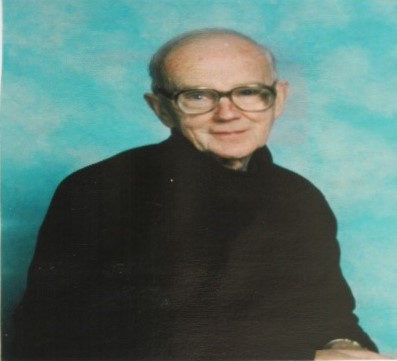
He loved the school and the children with one of the highlights of his year being the May Procession when a statue of Our Lady was carried around the grounds and the church. His Golden Jubilee came in July 1997 but he did not want any celebrations of it in the parish. He went off to Lourdes to spend it in the way he preferred. He was quite touched, on his return, to discover that so many parishioners had marked the occasion with cards and little presents for him.
2001 started with parishioners growing ever more concerned about his state of health. In March he was unable to carry on and was taken into hospital. Fr. Dominic McGivern, who lived in Durham, was asked by the Bishop to look after the parish for a few weeks. It became clear the Fr. Hughes was not going to be able to return to his duties, and by the end of April he had taken up residence with the Little Sisters in Newcastle. Fr. Hughes died on January 23rd 2004.
A Decade of Change
Fr. Dominic McGivern came to St. Patrick’s in April 2001 and made quite an impact during his few weeks in the parish. He began to organise the special ministers to take Holy Communion to the sick and housebound, he encouraged more altar servers to come forward and, in response to expressed interest, he helped to organise a choir.

On Sunday May 19th 2001 Bishop Ambrose visited the parish and celebrated Mass. The following week an announcement was made that Fr. Tony Battle was going to be the new parish priest, which was followed by a letter from Fr. Tony in June, before he took up residence in the presbytery at the beginning of July.
Fr. Tony had only been parish priest for about three months when the first warnings were sounded about groupings of parishes. With these proposals in mind Fr. Tony asked for volunteers to train as lay leaders and got six people who were willing to do so.
A social committee had been formed after the coming of Fr. Tony and he asked them to organise a party for the parish to celebrate his 60th birthday on February 9th 2003. The party was a great success and all the proceeds were given to the Lourdes Fund.
At the Masses on the weekend of Sunday 10th March we were given the news that Bishop Ambrose had asked Frs. Tony Battle and Martin Morris to assume responsibility for Esh and Langley Park, as well as their present duties. Changes were taking place in the higher echelons of the Diocese in that Bishop Ambrose had retired and, by June, we had Bishop Kevin Dunn as our new Bishop, hearing his first letter to the people of the diocese on Saturday June 18th 2004.
As the year progressed people began to realise that Fr. Tony was not well. In November he told parishioners that he had been struggling for a couple of months with an abdominal complaint which was now under hospital investigation. He was hoping for a diagnosis soon and some course of helpful treatment to see a return to health. This was not to be and by early December a tumour on the liver had been revealed. Fr. Stephen Watson was sent to the parish to assist Fr. Martin while Fr. Tony was ill. On Monday January 3rd 2005 Fr. Tony died peacefully at 5pm. Fr. Stephen Watson continued to serve the parish and the cluster with Fr. Martin but in June 2005 we were given news of yet more change. Fr. Martin Morris was leaving Ushaw Moor St. Joseph’s, and the cluster, to go to St. Aloysius, Hebburn. We received a letter from Fr. Michael Griffiths of St Aloysius, Hebburn to say that the Bishop had asked him to be the co-ordinating pastor of all five churches.

Fr. Stephen stayed until September when he left to study in Rome for a year. Fr. Alan MacKnight, recently retired, moved into the apartment in the church house in September to lend a hand in the cluster. A period of relative stability followed, the only changes in 2006 being the movement of Holydays which were solemnities of the Lord being moved to Sundays.

On Sunday July 12th 2009 we were informed that Fr. Brian Murphy was coming in September to be responsible for St. Patrick’s and Willington. On September 1st Fr. Alan celebrated his last Mass at St. Patrick’s before his move to Dipton. Refreshments were provided afterwards in the school hall. On the weekend of September 20/21st we were glad to welcome Fr. Brian who had taken up residence in Willington – only ten minutes from St. Patrick’s by car.
Fr. Brian semi-retired in 2015 with sole responsibility for St. Thomas of Canterbury, Willington. Our parish was extremely fortunate with Fr. Robert Riedling’s appointment – from Sydney, Australia – who served St. Patrick’s in conjunction with his academic studies at Durham University, where he is postgraduate theology student.
In 2020, Fr Paul Hopper, a priest of the Congregation of the Holy Spirit (Spiritans) was appointed priest in charge. Unfortunately, his time at St. Patrick’s coincided with and spanned the outbreak of the Covid pandemic during much of which worship was suspended.
Easter 2021, saw the appointment of Canon Paul Douthwaite as Parochial Administrator. Canon Paul as well as serving the parish continues his work on a national level as the Bishops’ Conference of England and Wales National Catholic Chaplain for Prisons; overseeing some 340 Catholic Chaplains in 120 prisons.
Priests who have served St. Patrick’s, Langley Moor
(read more)Parish Priests
Fr. James Hanley 1876 –1880
Fr. Richard Hannon 1880 –1899
Fr Joseph Thorman 1899 –1905
Fr John Parker 1905 –1934 Curates
Fr. Charles Marshall 1928-1934
Fr. Thomas Meagher 1934–1936
Fr. Joseph McCormack 1936–1938
Fr. Austin McShane 1938–1976
Fr. Peter Stanley 1939–1941
Fr. Herbert Armstrong 1941–1947
Fr. Andrew Hannon 1947–1949
Fr. Dermot O’Sullivan 1949–1951
Fr. James Kenny 1951–1954
Fr. Anthony Bryce 1954–1960
Fr. John F. Brady 1960–1966
Fr. Eamonn Croghan 1966–1967
Fr. Gabriel Holmes 1971–1972
Fr. Michael Sweeney 1972–1974
Fr. James Donnelly 1974–1977
Fr. Thomas Laidler 1976–1979
Fr. Joseph Hughes 1979–2001
Resident in Parish
Fr. Hugh Lavery 1986-1995
Fr. Tony Battle 2001–2005
Caretaker Priests
Fr. Dominic McGivern 2001
Fr. Stephen Watson 2004-2005
Priests in Residence
Fr. Alan McKnight 2005-2009
Pastors from Newhouse
Fr. Michael Griffiths 2005-2009 Fr. Francis Reed 2005-2009
Fr. Brian Murphy 2009–2015
Priest in Charge
Fr. Robert Riedling 2015- 2020
Fr. Paul Hopper C.S.Sp. 2020-2021
Parochial Administrator
Canon Paul Douthwaite 2021-2022
Priest in Residence
Fr. Gordon Ryan 2022-
